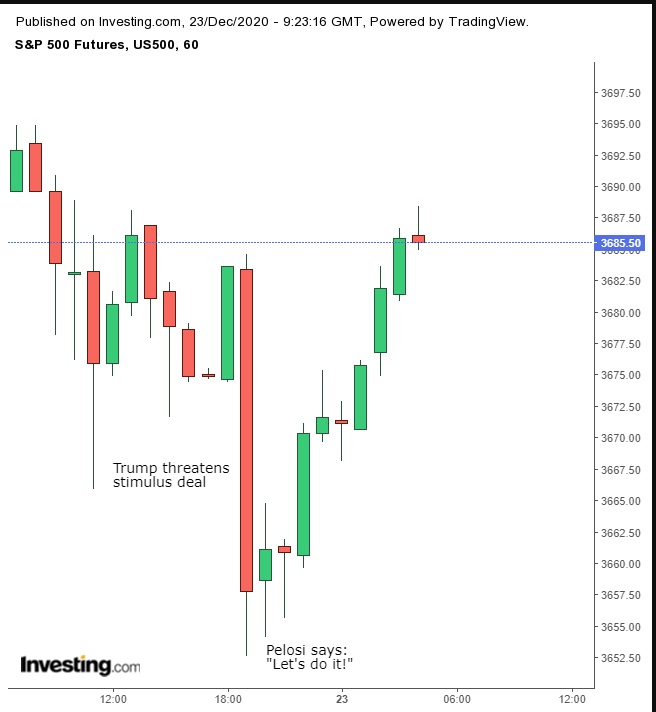- President Trump threatens to block stimulus bill unless personal check figure increased
- Regional markets, futures tumble
- Bitcoin hits new record close, then retreats
Key Events
After a sudden plunge at 7 PM Tuesday EST that took contracts down by 0.5%, US futures for the Dow Jones, S&P 500, NASDAQ and Russell 2000 all recovered early Wednesday morning.
At the same time, Asian trading moved higher and the European session opened in the green.
As of this writing, markets are more buoyant. The earlier, abrupt descent occurred on news that US President Donald Trump was threatening}} to not sign the much-anticipated, heavily-negotiated stimulus package that US lawmakers had finally agreed on. Calling it "a disgrace," the President said he wanted the amount of individual stimulus to be raised to $2000, rather than the $600 figure that's currently in the bill.
Since fiscal stimulus has been repeatedly propelling the markets to new records amid one of the most uncertain periods in market history, investors have been counting on yet another round of US largesse to keep momentum going. With Trump's unexpected move to block the passage of the bill just as the fiscal aid package was nearing the 'finish line,' investors' frayed nerves appeared to have finally collapsed on the news, in the aftermath of ongoing fears of a new strain of COVID-19.
Gold and oil moved higher this morning. The dollar slipped lower
Global Financial Affairs
Trader have been in a defensive posture since the director of the US's National Institute of Allergy and Infectious Diseases, Dr. Anthony Fauci warned the new virus variant found in the UK is already likely in the States.
So why did US futures recover so quickly and keep rallying? In response to Trump's demand to up the personal check ante, House Speaker Nancy Pelosi tweeted, "Let’s do it!” Markets immediately reversed higher.

The $2K figure was the exact sum Democrats had wanted all along.
The STOXX 600 Index jumped this morning following reports that "a Brexit trade deal could be struck later in the day." The pound opened 0.3% higher and extended the advance to 0.5%, as of this writing.
Yields, including for the 10-year benchmark Treasury, rebounded.

Rates bounced off the bottom of a pennant within a rising channel, ultimately leaving yields flat, tracking the same pattern as US futures.
The dollar retreated from a three-day rally.

The greenback tested a rising flag and confirmed resistance.
Gold retested a H&S bottom within a falling channel.

The precious metal closed precisely above the H&S neckline and has been climbing since.
Bitcoin is retreating from its new record close of $23,805, one dollar more than Saturday’s highest closing price.
Oil rebounded, paring a 1.8% plunge ahead of this week's EIA inventory report.

The price of WTI is forming an intraday hammer that's finding support at Monday's lows. The bullish nature of the pattern would only go into effect after a close at or above that level. The price is still below its uptrend line since the Nov. 2 low.
Up Ahead
- US initial jobless claims, {{ecl-222||new home sales data are released Wednesday.
- Core durable goods orders are reported on Thursday in the US.
Market Moves
Stocks
- Futures on the S&P 500 Index climbed 0.2%.
- The Stoxx Europe 600 Index increased 0.5%.
- The MSCI Asia Pacific Index advanced 0.7%.
- The MSCI Emerging Markets Index gained 0.6%.
Currencies
- The Dollar Index fell 0.3% to 90.35.
- The euro increased 0.1% to $1.2179.
- The British pound jumped 0.4% to $1.3419.
- The onshore yuan strengthened 0.1% to 6.537 per dollar.
- The Japanese yen strengthened 0.2% to 103.46 per dollar.
Bonds
- The yield on 10-year Treasuries decreased less than one basis point to 0.91%.
- The yield on two-year Treasuries gained less than one basis point to 0.12%.
- Germany’s 10-year yield sank one basis point to -0.60%.
- Britain’s 10-year yield declined less than one basis point to 0.179%.
- Japan’s 10-year yield advanced less than one basis point to 0.012%.
Commodities
- West Texas Intermediate crude declined 0.7% to $46.70 a barrel.
- Brent crude dipped 0.6% to $49.77 a barrel.
- Gold strengthened 0.4% to $1,868.85 an ounce.
